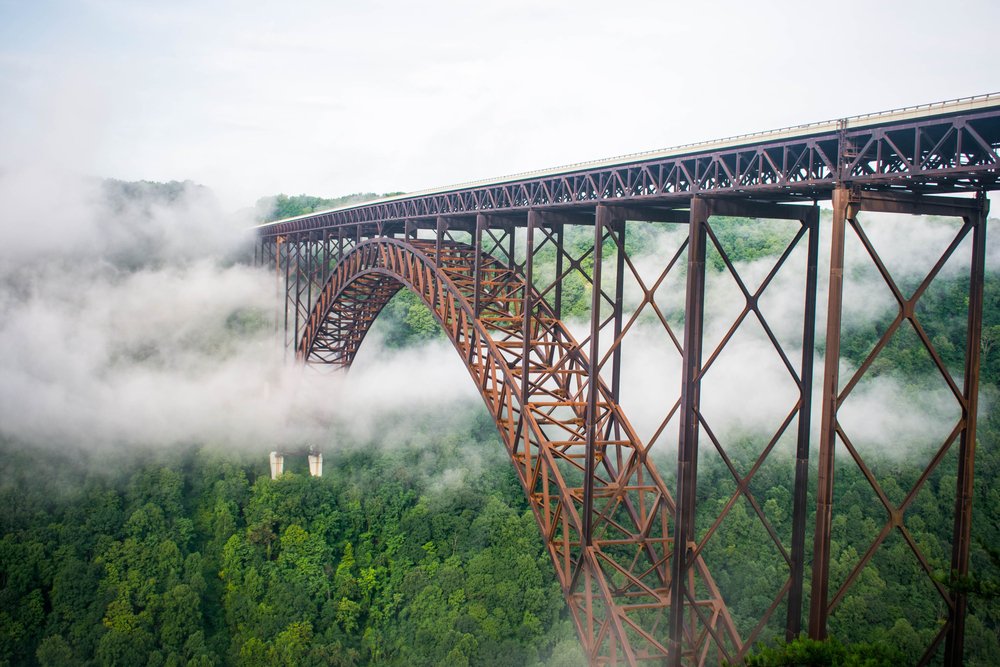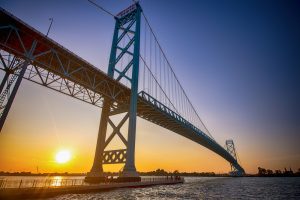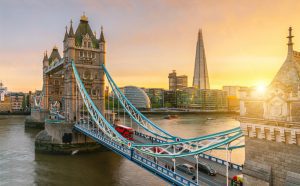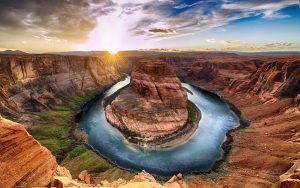Many states across the US have spent billions of dollars over the years to create some of the most spectacular bridges, taking you across gorges, rivers, mountain paths, and even the sea.
Some bridges are breathtakingly beautiful yet scary, especially when you get up close. They all have their significance, from memorials to high-end designs and historical landmarks.
If you’re scared of heights or can’t make it to any of these significant structures, you’ll enjoy these images and details of the 25 tallest bridges in the USA.
Table of Contents
The Tallest Bridges in the United States
| Number | Bridge | Height (ft) |
|---|---|---|
| 1 | The Royal Gorge Bridge | 955 |
| 2 | Mike O’Callaghan–Pat Tillman Memorial Bridge | 900 |
| 3 | New River Gorge Bridge | 876 |
| 4 | Foresthill Bridge/Auburn Bridge | 730 |
| 5 | Skywalk at the Grand Canyon | 720 |
| 6 | The Phil G. McDonald Bridge | 700 |
| 7 | Glen Canyon Bridge/Glen Canyon Dam Bridge | 700 |
| 8 | The Glen Canyon Dam Suspension Footbridge | 640 |
| 9 | Bidwell Bar Bridge | 627 |
| 10 | The Rio Grande Gorge Bridge | 565 |
| 11 | Perrine Bridge | 486 |
| 12 | Navajo Bridge | 470 |
| 13 | Moyie River Canyon Bridge | 464 |
| 14 | Pine Valley Creek Bridge | 450 |
| 15 | Cold Spring Canyon Arch Bridge | 400 |
| 16 | Burro Creek Bridge | 388 |
| 17 | High Steel Bridge | 375 |
| 18 | Hoffstadt Creek Bridge | 370 |
| 19 | Lewiston–Queenston Bridge | 370 |
| 20 | Hansen Bridge/Veterans Memorial Bridge | 350 |
| 21 | Vance Creek Bridge | 347 |
| 22 | Thomas Creek Bridge | 345 |
| 23 | Fred G. Redmond/Selah Creek Bridge | 325 |
| 24 | Crooked River Railroad Bridge | 320 |
| 25 | Rex T. Barber | 300 |
1. The Royal Gorge Bridge: 955 ft
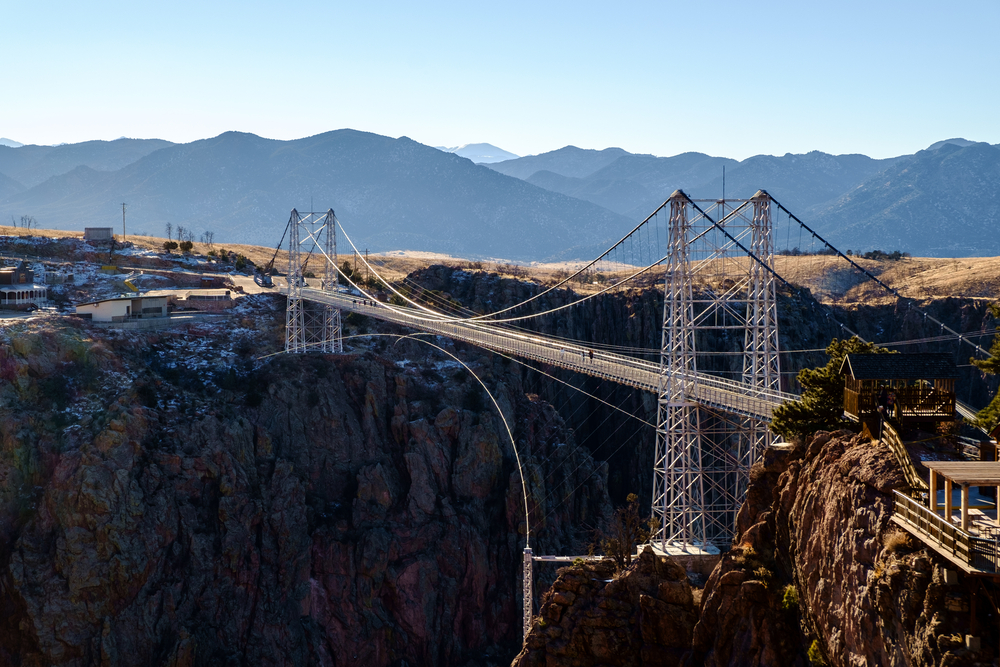
Hovering nearly one thousand feet above the Arkansas River, the Royal Gorge Bridge, created in 1929, is the tallest bridge in the United States.
The 955-foot bridge also ranks eighth when measured against the most elevated bridges in the world.
People began using this suspension bridge, located in the vicinity of Canon City, Colorado, in December 1929. Royal Gorge was designed by famous architect George E. Cole.
Cole also built the structure, using his construction company, which took about five months to complete. The bridge forms part of a paid entrance park and attracts thousands of onlookers annually.
2. Mike O’Callaghan–Pat Tillman Memorial Bridge: 900 ft
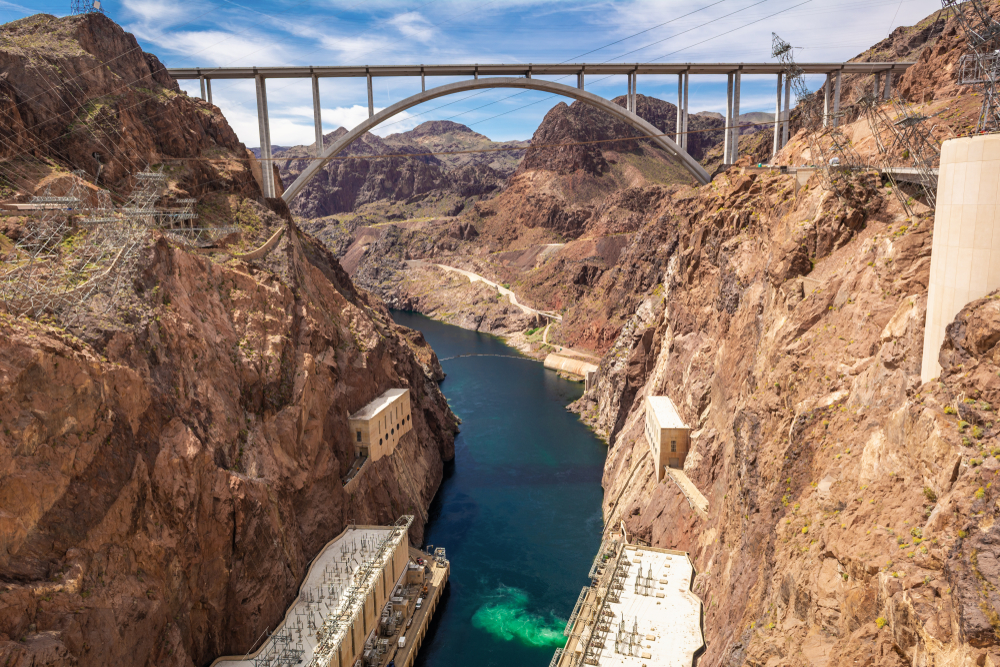
The Mike O’Callaghan–Pat Tillman Memorial Bridge is the second tallest bridge in the country at 900 feet, just 55 feet lower than the Royal Gorge Bridge.
Not only is this memorial bridge massive, but it cost a whopping 114 million dollars to construct, outshining all its US competitors.
Mike O’Callaghan, a former Nevada governor, and Pat Tillman, a former football player who was gunned down in Afghanistan while serving in the US Army, are the bridge honorees.
Construction took place over five years, from 2005 to 2010. Of the tallest bridges in the country, the Mike O’Callaghan-Pat Tillman Memorial Bridge is the most recently constructed.
3. New River Gorge Bridge: 876 ft
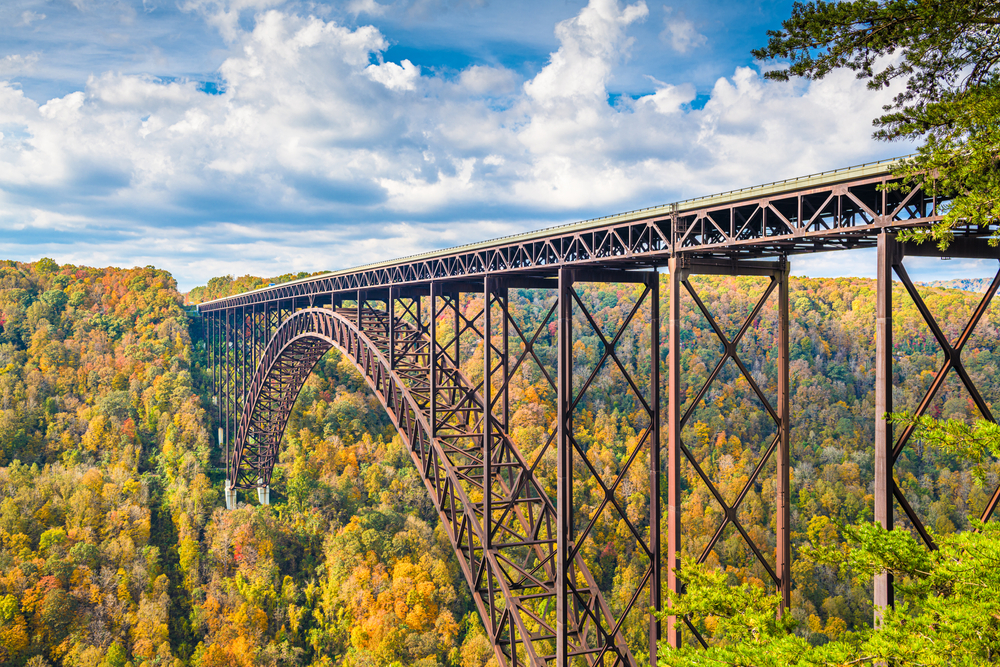
This 37 million dollar West Virginia bridge ranks third among the tallest bridges in the USA at 876 feet and is the longest in the country and fourth-longest globally.
Its construction took only three years, from 1974 to 1977, and was open to the public in October 1977.
The New River Gorge bridge is heavily used by motorists, with just over 16 thousand vehicles crossing it daily. The bridge, which spans the Fayette County’s New River, is a tall steel arch bridge.
The vast, Cor-Ten steel bridge was designed by the Michael Baker Company and was built by the US Steel’s American Bridge Division.
4. Foresthill Bridge/Auburn Bridge: 730 ft
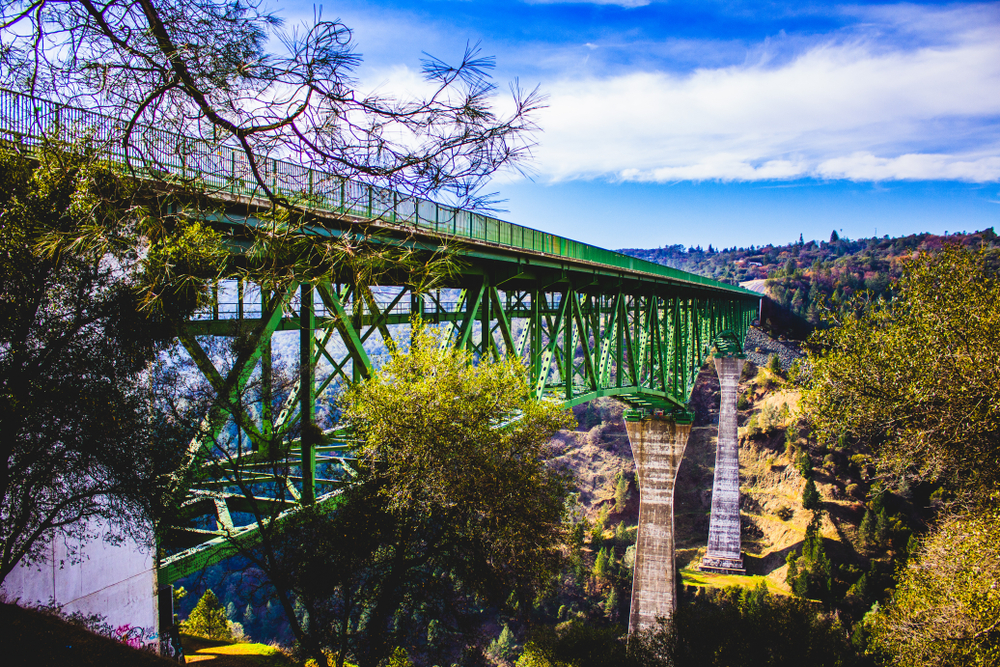
The Foresthill Bridge construction cost about 13 million dollars in 1973, with Willamette Western Contractors undertaking its construction in Placer County, California.
Foresthill is a road bridge that spans the North Fork American River and has a total length of 2,428 feet and 730-foot height. The vastness makes it California’s tallest bridge and the country’s fourth tallest.
The elevated bridge, commonly referred to as the Auburn Bridge, handles both vehicular and pedestrian traffic. In 1971, Japanese engineering company Kawasaki Heavy Industries completed the fabricated steel deck of the bridge.
5. Skywalk at the Grand Canyon: 720 ft
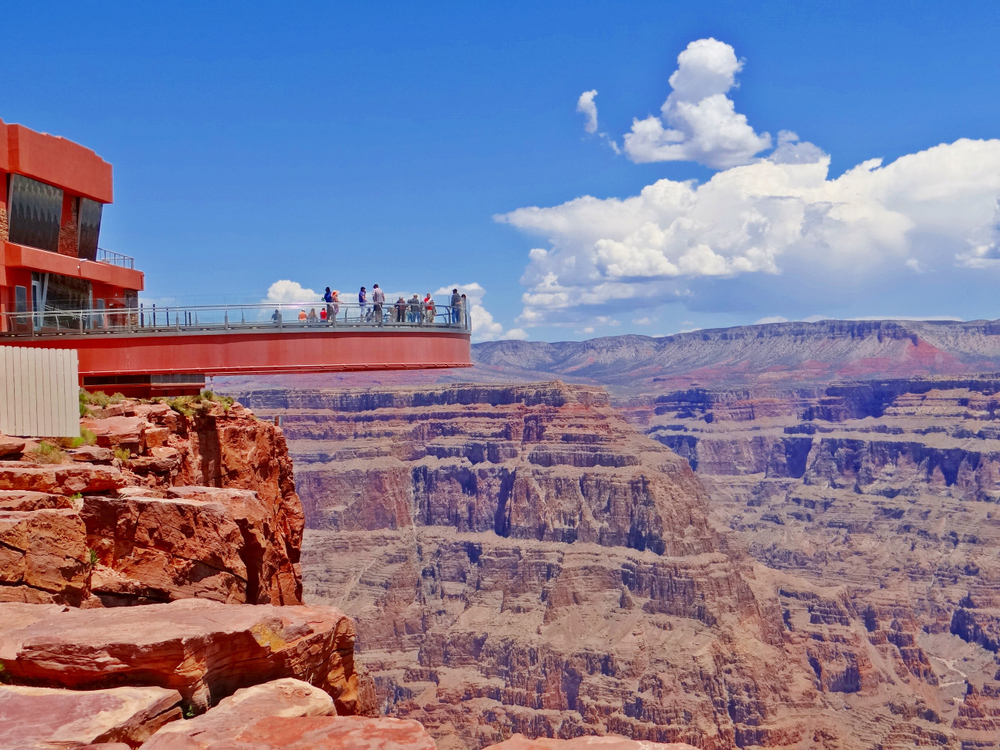
Head over to Eagle Point, Arizona, and enjoy looking at this bridge, which is shaped like a U or a horseshoe, and hangs 720 feet over the Colorado River.
This attraction has seen as many as one million visitors, so be prepared to compete with many others for the spectacular view and walk.
Known as the Skywalk Bridge and equipped with a walkway made of glass, it runs alongside the western region of the main canyon.
This beautiful walking path is 4,770 feet long. The exact vertical drop just beneath the skywalk is between 500 and 800 feet.
6. The Phil G. McDonald Bridge: 700 ft
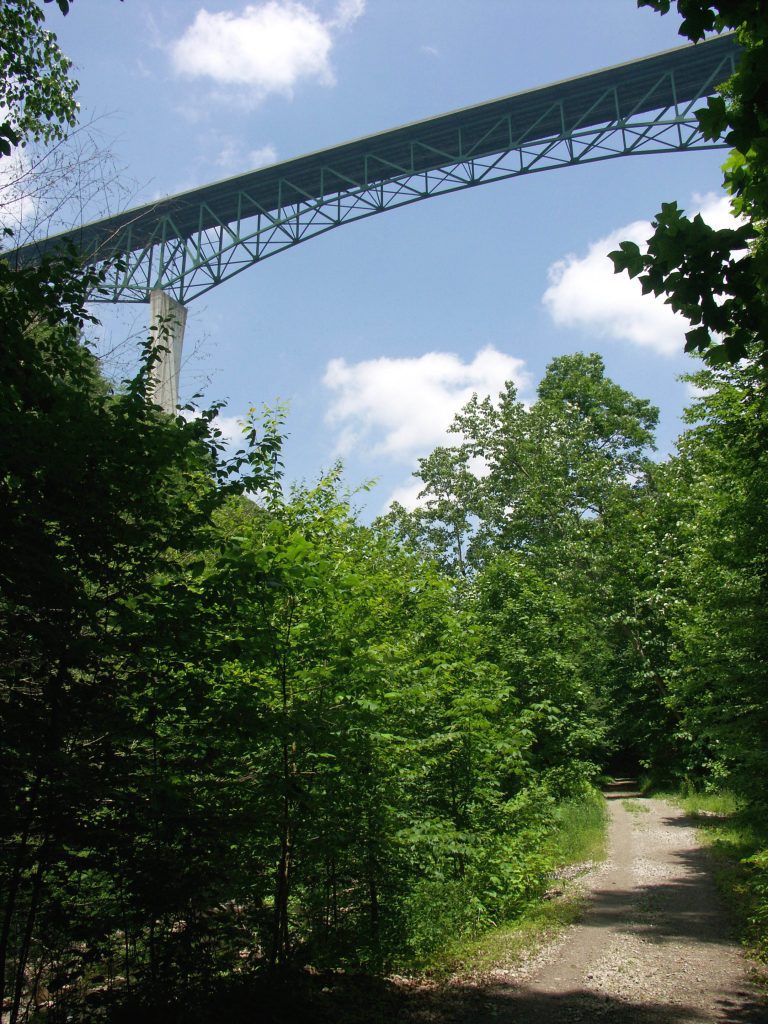
If you hear people in Raleigh County, West Virginia, talking about the Glade Creek Bridge, don’t worry; it is the same.
Whether Glade Creek or Phil G. McDonald Memorial Bridge, this deck truss-designed bridge stands high at 700 feet and is not for the faint of heart.
Phil G. McDonald, from whom the bridge got its name, was a decorated veteran who served in Vietnam.
You may have driven across this bridge if you’ve been in the area, as it forms part of Interstate 64. Unsurprisingly, it is higher than all other bridges that fall into the Highway Interstate system.
After 29 million dollars of construction, the bridge opened to motorists in July 1988. The West Virginia Department of Transportation owns the bridge.
7. Glen Canyon Bridge/Glen Canyon Dam Bridge: 700 ft
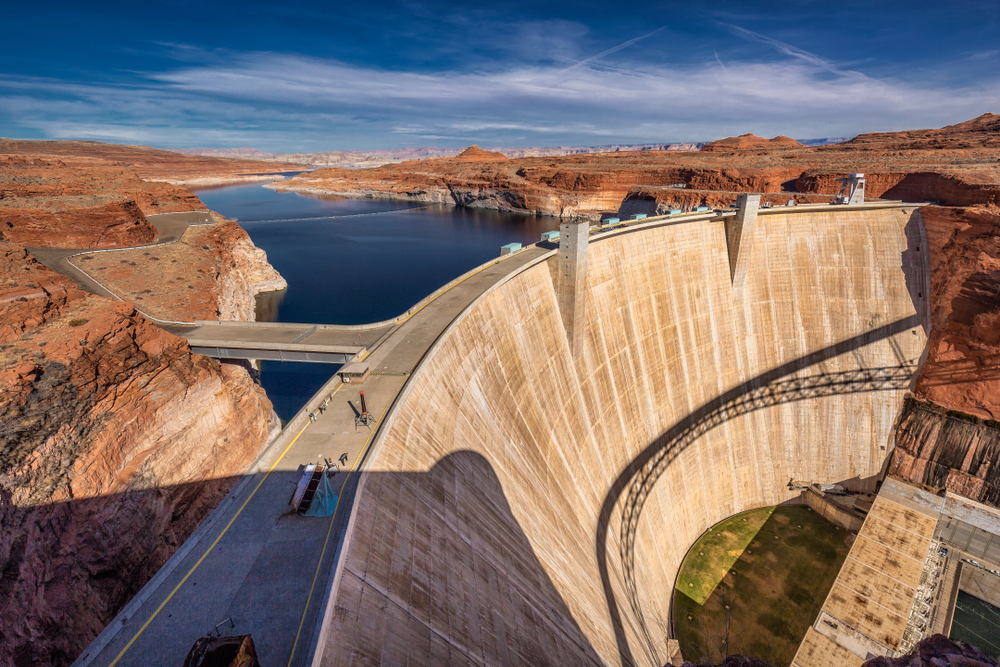
Coconino County, Arizona, is where you’ll find the seventh-tallest bridge in the United States, standing 700 feet over the Colorado River. Back in 1959, when construction took place, this steel bridge had the highest arch worldwide.
This bridge spanned the Colorado River and was constructed by the United States Bureau of Reclamation to create easier access for dam-building materials.
Hence, people commonly call the bridge the Glen Canyon Dam Bridge as well. The bridge has two lanes.
8. The Glen Canyon Dam Suspension Footbridge: 640 ft
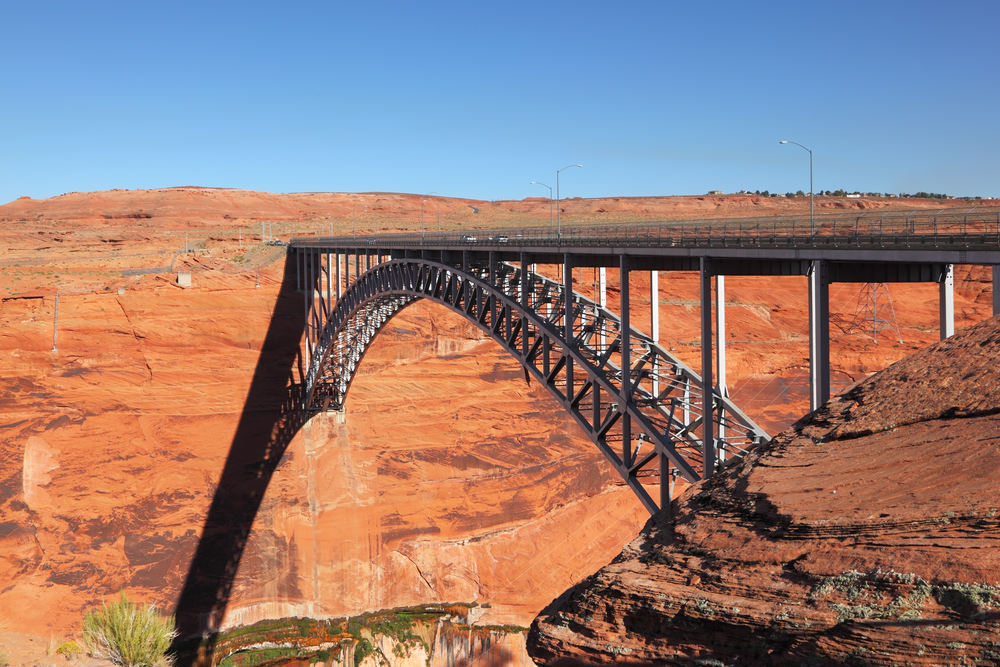
The Suspension Footbridge hovers 640 feet over the canyon. It is soaring, but not nearly as tall as the Aizhai Bridge, the world’s highest suspension bridge (1150 feet).
Between 1958 and 1964, the Glen Canyon Dam Bridge was constructed to aid workers in constructing the enormous Glen Canyon Dam. The dam construction began in 1956 and took over seven years to complete.
When the footbridge reached completion, the workers could walk across the river from the south bank, where the town of Page lies.
As people walked over the bridge, they could see right through to the river, so getting through the “chicken wire” was not as simple as it appeared.
9. Bidwell Bar Bridge: 627 ft
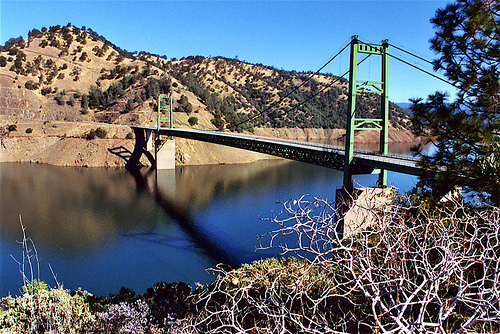
Thirty-four million dollars is what California spent to design and construct this replacement suspension bridge back in 1965. The cost was more than 33 million dollars above the original price for this iconic landmark.
In 1966, the state built a new bridge with a length of 1,108 feet or 338 meters, just over a mile north of the initial bridge position.
It was one of the world’s largest suspension bridges at the time, rising 627 feet above the natural riverbed, but since the creation of a new lake (at the request of the local community and preservationists), the bridge now sits just above the water.
The original bridge is a California Historic Landmark, and the American Society of Civil Engineers designated it as a Historic Civil Engineering Landmark.
10. The Rio Grande Gorge Bridge: 565 ft
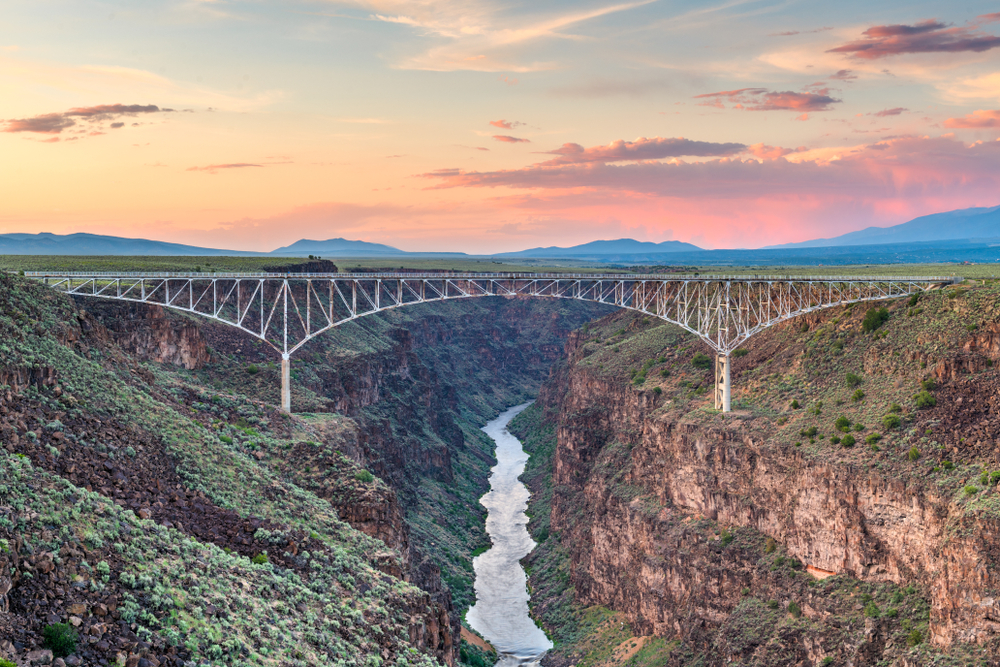
The Rio Grande Gorge Bridge was constructed between 1963 and 1965. Visitors who cross it, like those who traverse many other high bridges in the US, are rewarded with a breathtaking scenic view.
The bridge has a height of 565 feet and a width of 1050 feet.
Several organizations and famous figures have complimented the bridge’s architecture, notably the American Institute of Steel Construction and the Most Beautiful Long Span Steel Bridge of 1966, among many other commendations.
11. Perrine Bridge: 486 ft
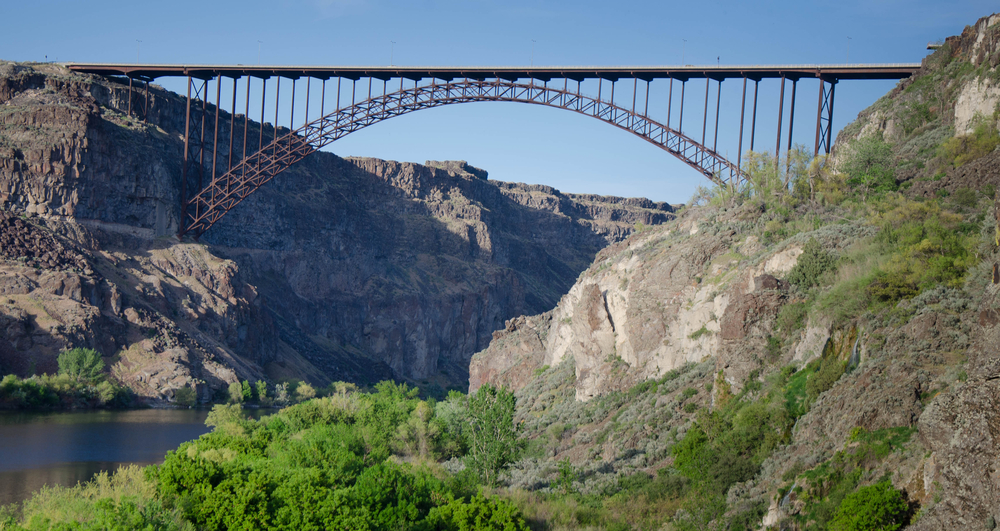
Decades ago, the I.B. Perrine Bridge got its first name, Twin Falls Jerome Inter-county Bridge. It changed ownership when Idaho repurchased it in 1944 for $482,000, equivalent to 7 million dollars today.
Scores of tourists flock to this four-lane truss arch-design bridge regularly. The increased tourism is unsurprising – the bridge is 1500 feet long and hovers 486 feet over Idaho’s Snake River and is a beauty to behold.
In 1970, the bridge was renovated because it outgrew its daily level of traffic. It cost over ten million dollars to replace the original bridge and bring it to its current state, which can now handle all the US Highway 93 traffic that crosses it.
I.B. Perrine, a man who led many irrigation projects in Idaho in the early to mid-20th century, played an integral role in establishing this bridge and naming the structure in his honor.
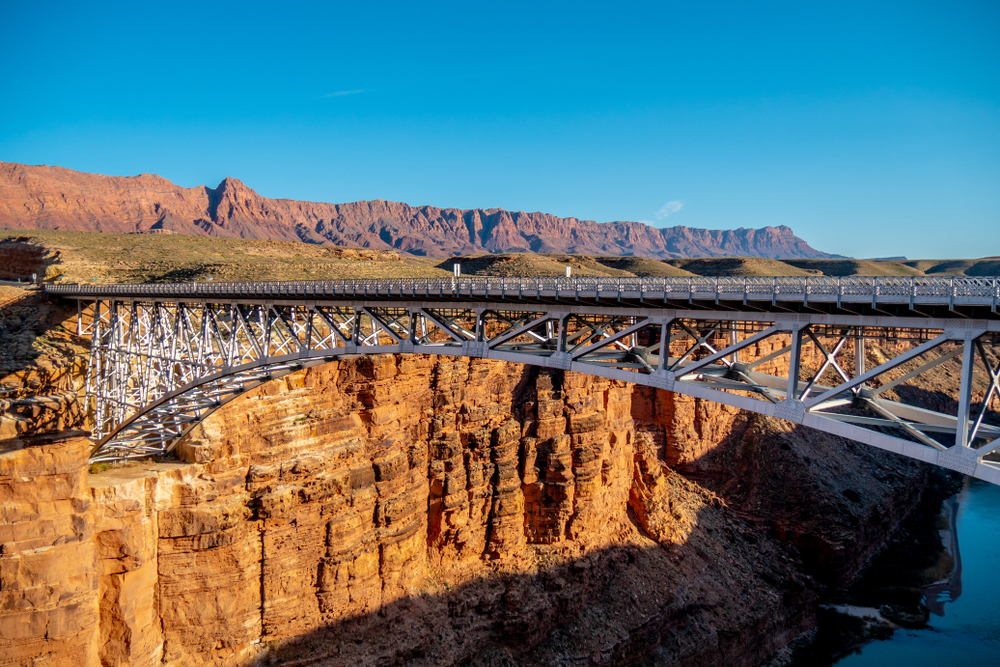
The Navajo Bridge is one of those rare structures with the original standing by its side. Both the original and updated bridges are spandrel-Arch designed and hover over the Colorado River and the Grand Canyon National Park.
The new bridge carries vehicles traveling along US Route 8. The new bridge was necessary because the original one had outgrown its capacity, and it did not meet the Federal Highway standards.
In 1929 the bridge was dedicated with the original name, Grand Canyon Bridge.
It has a 470-foot drop down to the Colorado River, and its impressive structure draws the attention of passers-by and tourists alike. The bridge is 800 feet high and 34 feet in length and can handle up to 22.5 tons at any given time.
The bridge reached completion in May 1995 and cost the Arizona Department of Transportation 14.7 million dollars to construct.
The original bridge remains open for equestrian and pedestrian use and has been deemed a historic civil engineering landmark by the country and its home state of Arizona.
13. Moyie River Canyon Bridge: 464 ft
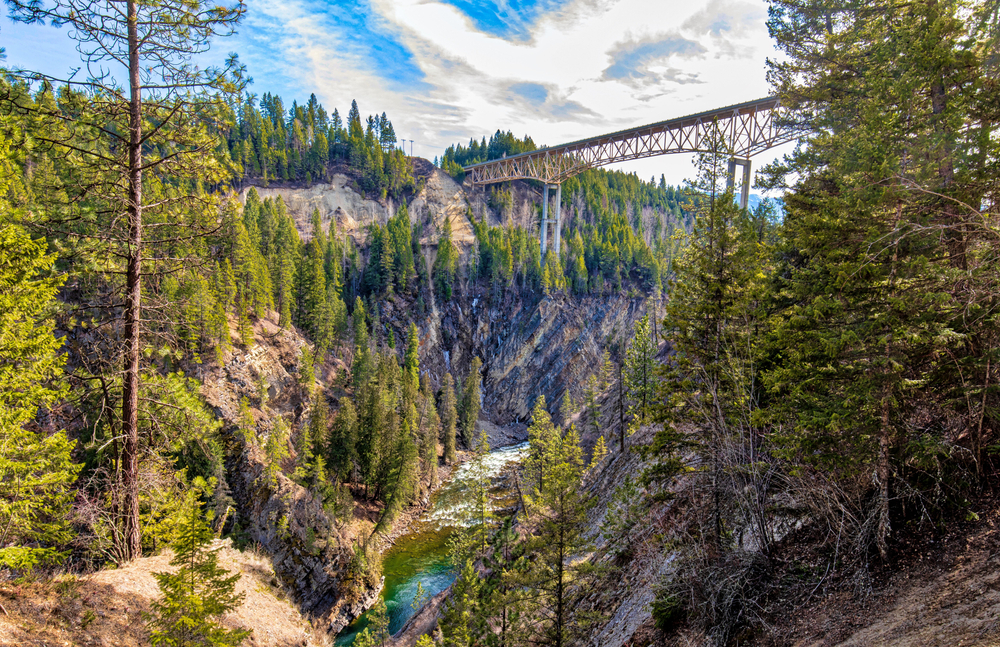
This Idaho Bridge sits over the Moon River and is 464 feet high and spans 1223 feet. It is a cantilever bridge with a structural steel truss design.
This bridge was constructed to replace a bridge that was deemed no longer functional back in 1923, although several decades passed before the new bridge was opened.
This bridge is one of three incredibly high bridges in the state of Idaho. The Moyie River Canyon Bridge forms part of US Highway 2 and carries two lanes of traffic.
Located in Moyie Springs, Idaho, the Idaho Transportation Department maintains the bridge. The longest span of the bridge is 377 ft. The new bridge was opened in 1965 and is very popular both for locals and tourists.
14. Pine Valley Creek Bridge: 450 ft
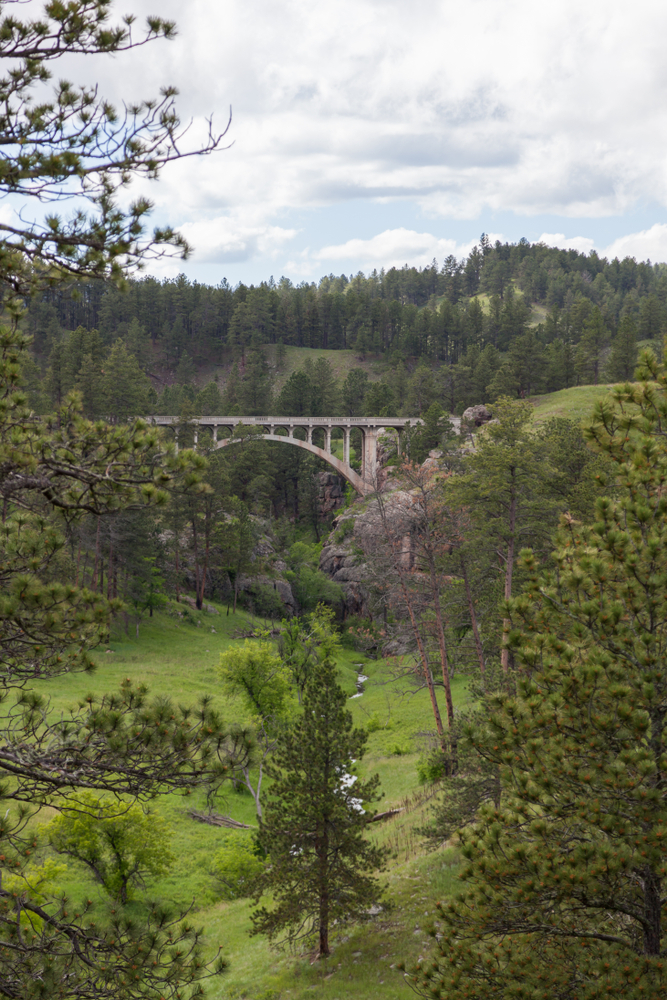
The Pine Valley Creek Bridge, a box border bridge, ranks number 14 for the tallest bridges in the United States. Its widest span is 1,691 feet, and it stands 450 feet above the valley below.
Another popular name for the Pine Valley Creek Bridge is Nello Irwin Greer Memorial Bridge. It lies in the San Diego County region of California and is the tallest bridge in the state.
The Pine Valley Creek Bridge was constructed in 1974 and handles traffic from Interstate 8 (I-8). At the time of its culmination, it was the first bridge in the country to utilize the segmental balanced cantilever technology.
15. Cold Spring Canyon Arch Bridge: 400 ft

The Cold Spring Canyon Arch Bridge links Santa Barbara to Santa Ynez, California. This impressive bridge is also part of State Route 154.
At its highest point, the bridge deck stands 400 feet above the canyon floor. The bridge is also the largest steel arch bridge in the state.
History societies determined that it met the criteria for listing on the National Register of Historic Places as a historically significant site.
16. Burro Creek Bridge: 388 ft
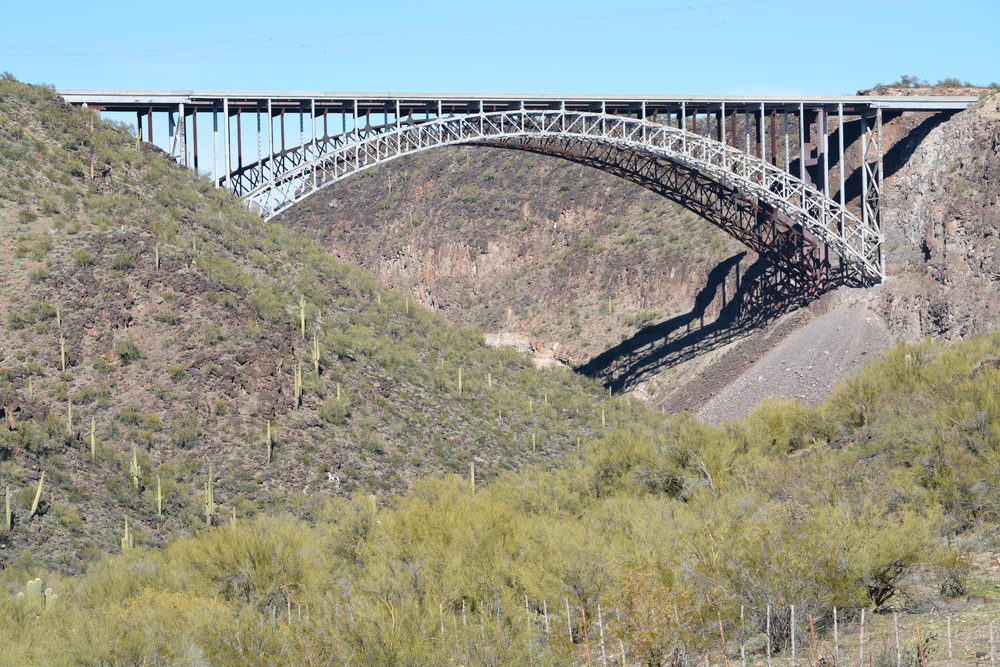
Buildings, antennae, spans, and earth (BASE) jumpers from the Phoenix area frequent this location with its 388-foot drop. It lies fifteen miles to the south of Wikieup, a town in Arizona.
The American Bridge Company erected the original, truss-designed, silver-colored two-lane bridge in 1966, and it spans 680 feet between hinges.
The state built a 700-foot second span parallel to the existing Burro Creek bridge in 2005. The 1966 span presently carries two lanes of northbound traffic, while the newer rust-weathered arch handles two lanes of southbound traffic.
The bridge is just up the river from a campground and wilderness area. Many campers make the trek up there to view the bridge from below, where you may trek along the south side of the creek and see the bridges from underneath.
17. High Steel Bridge: 375 ft
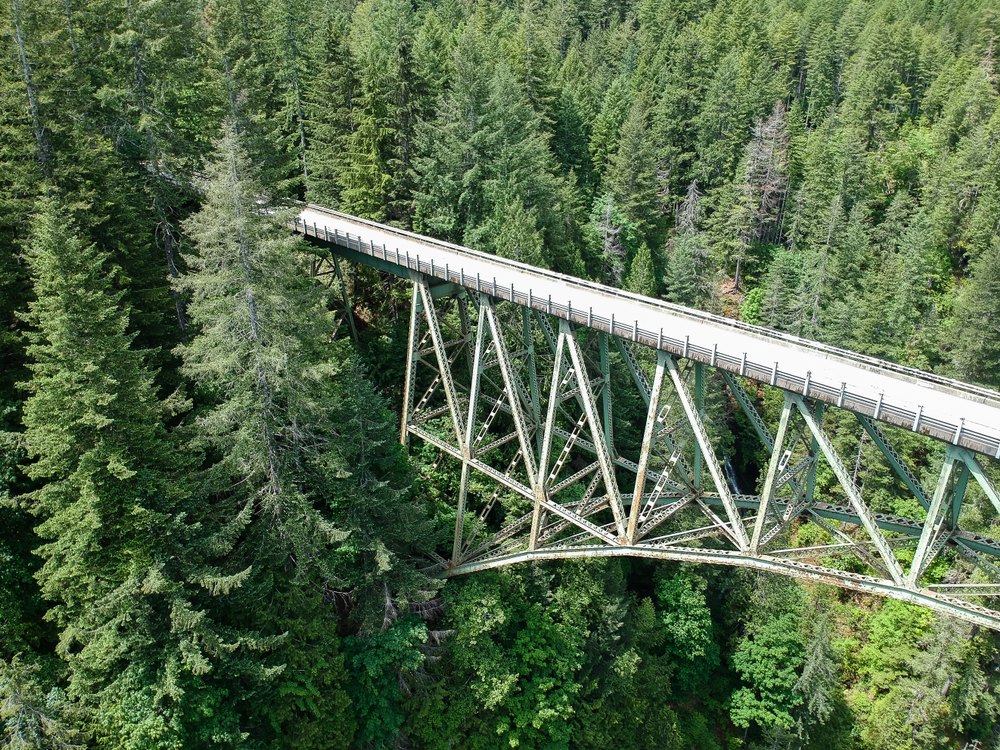
This picturesque bridge lies across the South Fork section of the Skokomish River at the height of 375 feet. It is a truss arch design, built to handle vehicles of all sizes (and even trains at one point). Up until 1964, it only served as a logging bridge.
Located in Mason County, Washington, this steel bridge has a span of 695 feet and on July 16, 1982, it was added to the National Register of Historic Places.
Created in 1929, this historic bridge initially carried a rail line that enabled logging operations in new areas of the Olympic Peninsula.
The Simpson Logging Company created it as one of two comparable bridges, which they contracted out to the American Bridge Company.
New rail lines for logging were becoming increasingly expensive throughout the construction period, so most businesses began employing trucks instead.
The bridges’ distinctive steel design was due to the high cost of rail. In contrast, most logging bridges were temporary timber structures; the Simpson Logging Company believed a permanent bridge be a better investment.
Although the bridge became a roadway, logging still takes place in this area.
18. Hoffstadt Creek Bridge: 370 ft
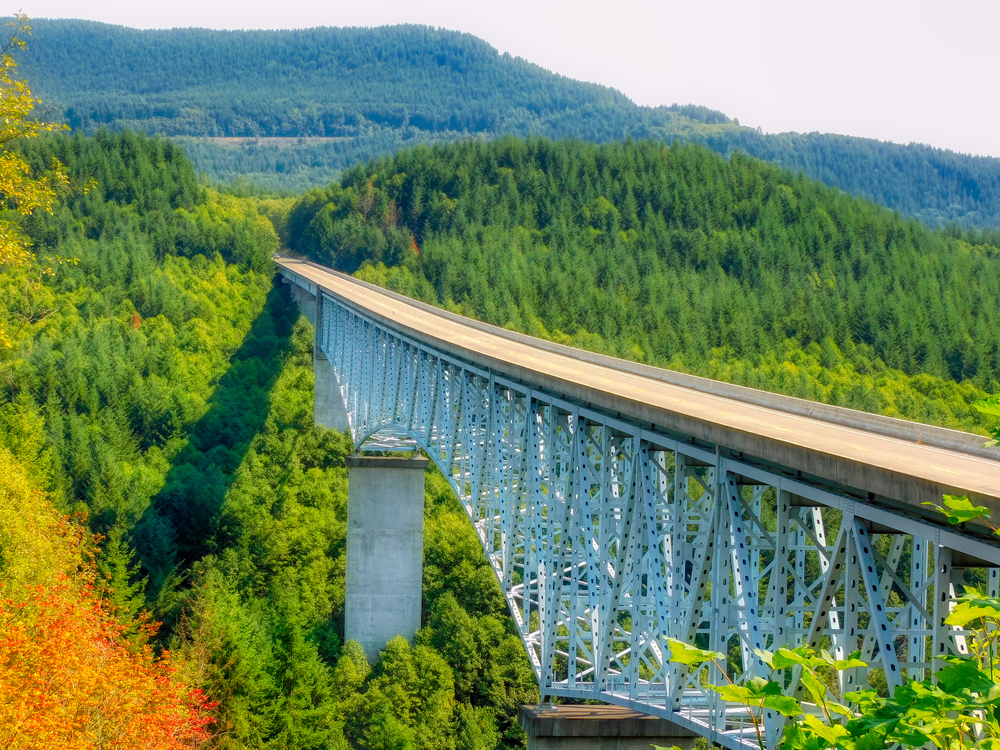
The $12.5 million deck-truss-designed bridge has a primary span of 600 feet and runs along Washington State’s Spirit Lake Memorial Highway.
The new roadway, which opened in 1991, was created to replace the former route, which was destroyed in 1980 when Mount St. Helens erupted.
The new route 504 better guards against debris runoff and flood damage since it is built high above the North Fork of the Toutle River.
The continuous truss was constructed by erecting 332-foot exterior spans on falsework and then cantilevering the 600-foot center span from each side.
Steel plate girders with spans ranging from 148 feet to 232 feet make up the approaches. Above the piers, the bridge’s truss attains a 56-foot depth. This multi-million dollar bridge is comprised of 2,505 tons of steel.
Shelby Bridge Co. was the contractor for this bridge, and its builders were Universal Structural and Western Pacific.
The American Institute of Steel Construction Inc. was awarded the Long Span Bridge Merit Bridge Award in 1996 for this bridge.
On Route 504, Hoffstadt Creek Bridge is rivaled only by the nearby, 260-foot Cow Creek Bridge.
19. Lewiston–Queenston Bridge: 370 ft
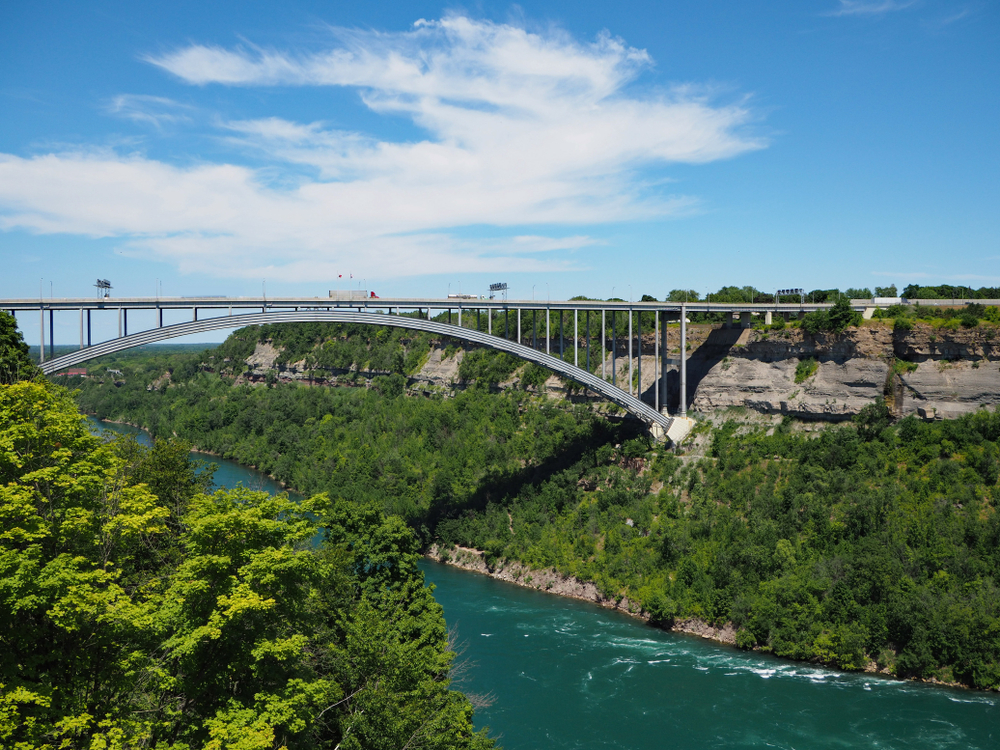
In 1972, the Lewiston–Queenston Bridge, which sits above the Niagara River gorge at 370 feet, began connecting international traffic between the United States and Canada.
It lies at the southern end of the Niagara Escarpment and on November 1, 1962, the bridge formally opened.
It connects the United States and Canada internationally, as well as Lewiston, New York, and Queenston, Ontario, through Interstate 190 and Highway 405, respectively.
Richard (Su Min) Lee created the Lewiston–Queenston Bridge, a replica of the Rainbow Bridge near Niagara Falls.
On both ends of the bridge, customs plazas are present, and there are required tolls when going into Canada. No pedestrians can use the bridge; however, authorized taxi services can.
The Lewiston–Queenston Bridge does not have NEXUS or FAST cardholders traveling from Canada to the United States, although it does have a NEXUS lane for transit into Canada.
Because the lanes are reversible, gantries include lights that indicate traffic direction. Along the bridge, you’ll see speed limits in kilometers and miles per hour (15 mph or 24 km/h).
On the south side of the bridge, Canadian and US flags flutter at the halfway point.
20. Hansen Bridge/Veterans Memorial Bridge: 350 ft
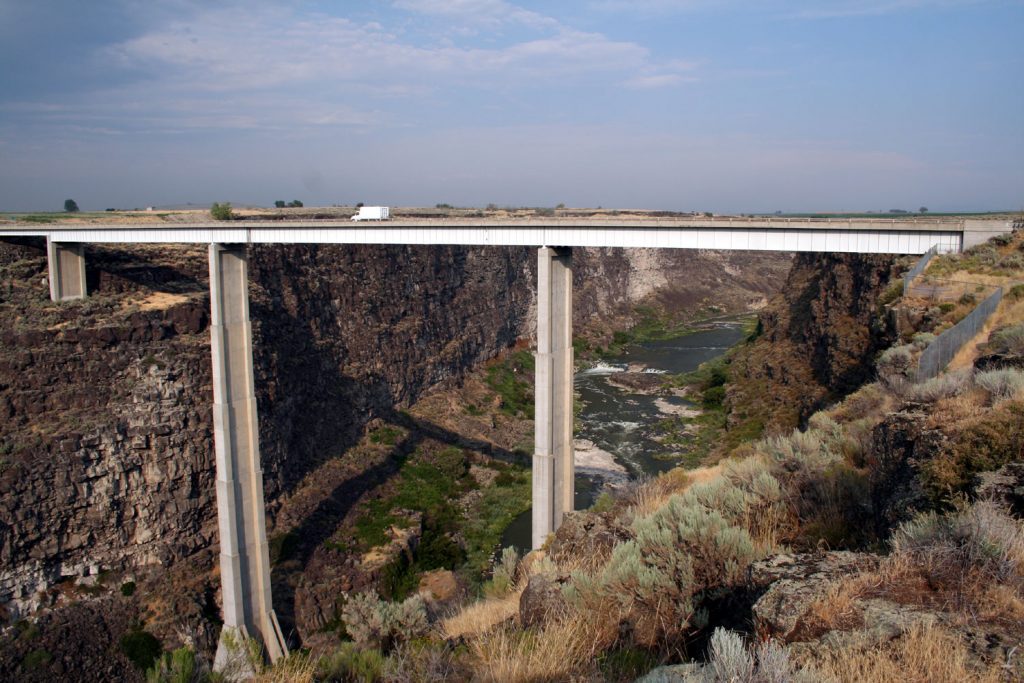
Three hundred fifty feet is the distance between the Hansen Bridge’s deck and the Snake River that flows beneath it. It is a girder design made of concrete and steel and connects two Idaho counties.
This bridge forms part of State Highway 50 and has three spans totaling 752 feet.
Hansen Bridge replaces the original, 100-thousand-dollar, 325-foot suspension bridge, as it was only capable of handling carriages and not modern vehicles.
In 1966, the new structure replaced the worn original just a mile north of Hansen in Twin Falls County, from which its name is derived. An average of nine thousand vehicles traverse this bridge daily.
21. Vance Creek Bridge: 347 ft
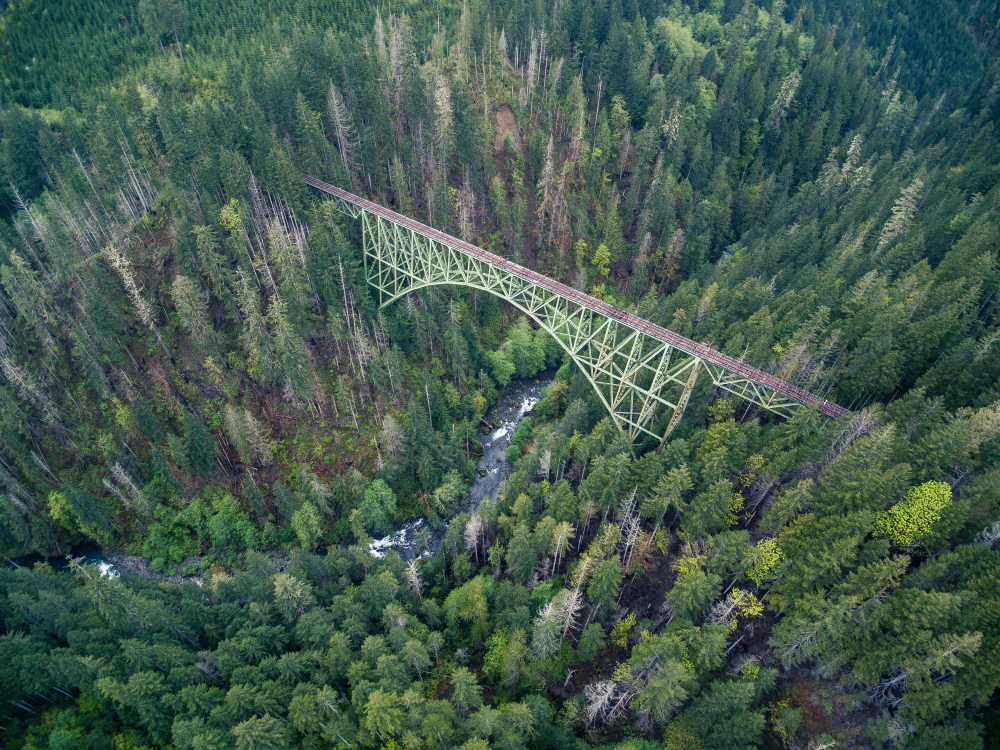
This railroad arch bridge is the second tallest of its kind in the United States. Built across Vance Creek, the bridge deck sits 347 feet above the river. It was built in 1929 by the Simpson Logging Company.
Located in Shelton, Washington, the Vance Creek Bridge forms part of the National Register of Historic Places(1982).
Despite never having been exposed to the public, the bridge became a popular destination for photojournalists and thrill-seekers in the early 2010s, as it is isolated and not safe in certain sections.
Authorities were forced to take steps to dissuade trespassers in 2016.
Green Diamond has indicated that deconstructing the bridge would be too expensive and harm the sensitive riparian habitat over which the bridge lies.
They’ve since begun discussions with Mason County Parks and a local bungee jumping outfit about leasing the bridge to them.
Like the Bridge to Nowhere in California, the company would restore the bridge deck to make it safe for pedestrian crossing and establish a bungee jumping location mid-deck.
22. Thomas Creek Bridge: 345 ft
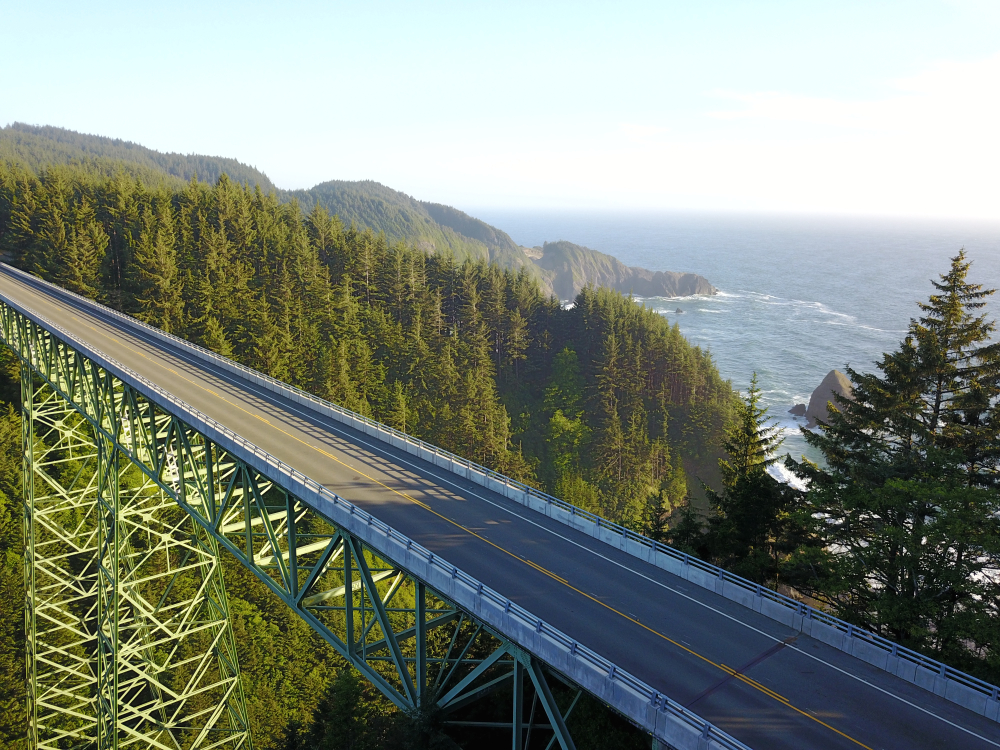
Over in Curry County, Oregon, you’ll see this 345-foot high bridge. Thomas Creek Bridge carries vehicular traffic for US Route 101 and is the tallest in Oregon state.
It is considered part of a state scenic area and runs along the Samuel H. Boardman borders.
With its Warren deck truss design, the bridge is 956 feet in length with its largest span measuring 371 feet. Ivan D. Merchant designed the beautiful bridge back in 1961, and thousands of motorists use it daily.
23. Fred G. Redmond/Selah Creek Bridge: 325 ft
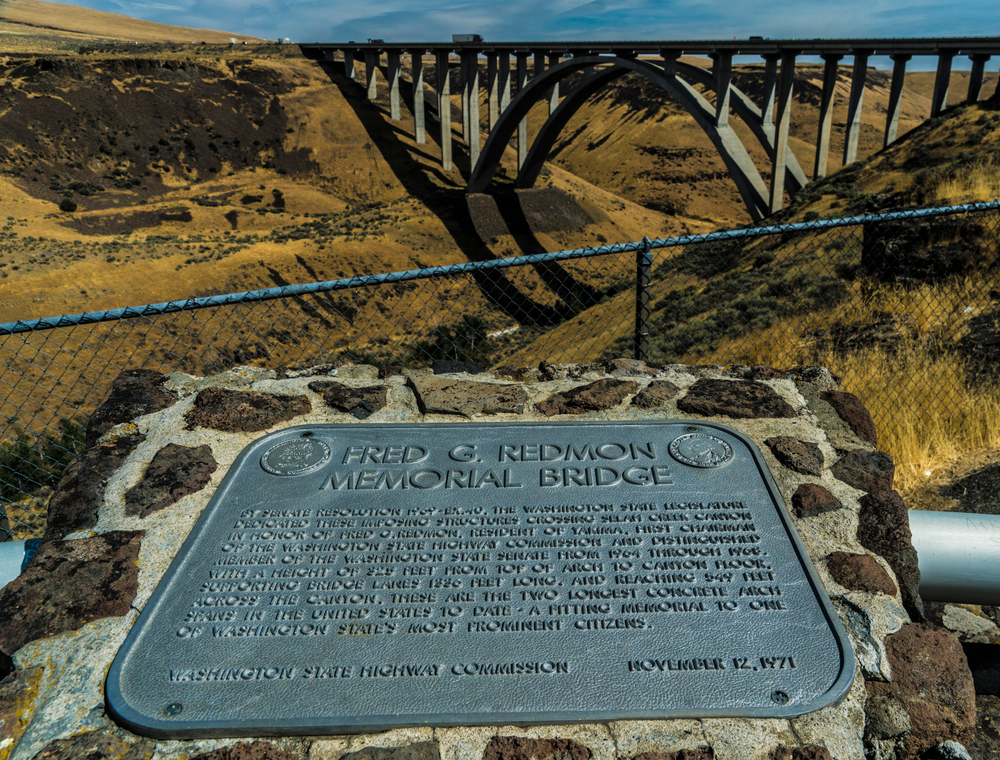
The twin arch designed Selah Creek Bridge, also known as the Fred G. Redmon Bridge, welcomed vehicular traffic in November 1971.
Standing at 325 feet high and spanning Selah Creek in Yakima County, Washington, the bridge handles Interstate 82 traffic.
Peter Kiewit & Sons built the structure as a 2.8-mile multi-million development along the Interstate 82 motorway. At that time, Selah Creek Bridge was the country’s longest concrete bridge and Washington’s tallest bridge.
In 1971, the Washington Aggregates and Concrete Association allotted the builders a Grand Award due to the bridge’s excellence in the utilization of concrete.
The Washington Highway Commission’s Chairman Fred Redmond is the bridge’s namesake, as the commission’s establishment in 1951 was to oversee the state’s roadways department.
24. Crooked River Railroad Bridge: 320 ft
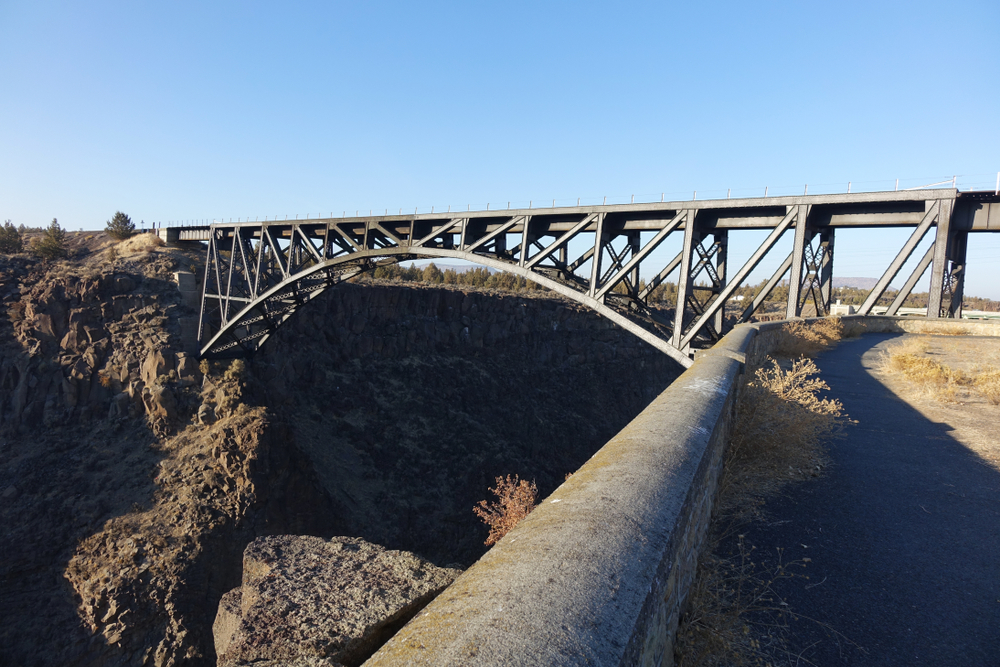
The steel arch design Crooked River Railroad Bridge spans Oregon’s Crooked River Canyon and is part of a railway line between the Columbia River and Bend, Oregon. The bridge rises 320 feet above the river and spans 460 feet.
In the competition to build a railroad up the Deschutes River Valley, the crossing of the Crooked River was crucial.
Great Northern Railway’s Jim Hill began operations on the west side of the Deschutes River, while Union Pacific’s Edward Harriman started operations at the opposite end.
The two railroads had to bridge the Crooked River, a significant tributary of the Deschutes, at 126 miles. There was just one spot narrow enough to allow for the construction of a bridge.
When Jim Hill’s Oregon Trunk Railroad bought the Central Oregon Railroad Company on December 1, 1909, he secured the rights to the area.
The Central Oregon Railroad had not installed any track, and the bridge site’s rights were its most valuable asset.
Hill’s property purchase forced Harriman to reach an agreement under which Hill’s railroad, the Oregon Trunk, would own practically the whole line from the Columbia to Bend. Still, Harriman’s firm would have the right to utilize it.
On May 18, 1911, they lowered the first steel for the bridge to the canyon’s bottom via derrick.
They needed steel beams, so men walked down rope ladders to tie cables to them, and they lifted the steel back up both sides of the canyon. Only four months later, on September 17, the first train crossed the bridge.
After trains began to use the bridge, the builders inserted half of the rivets holding it together. They constructed the bridge rapidly to reach the final 25.5 miles of in Bend, Oregon, where Jim Hill drove the first train.
25. Rex T. Barber: 300 ft
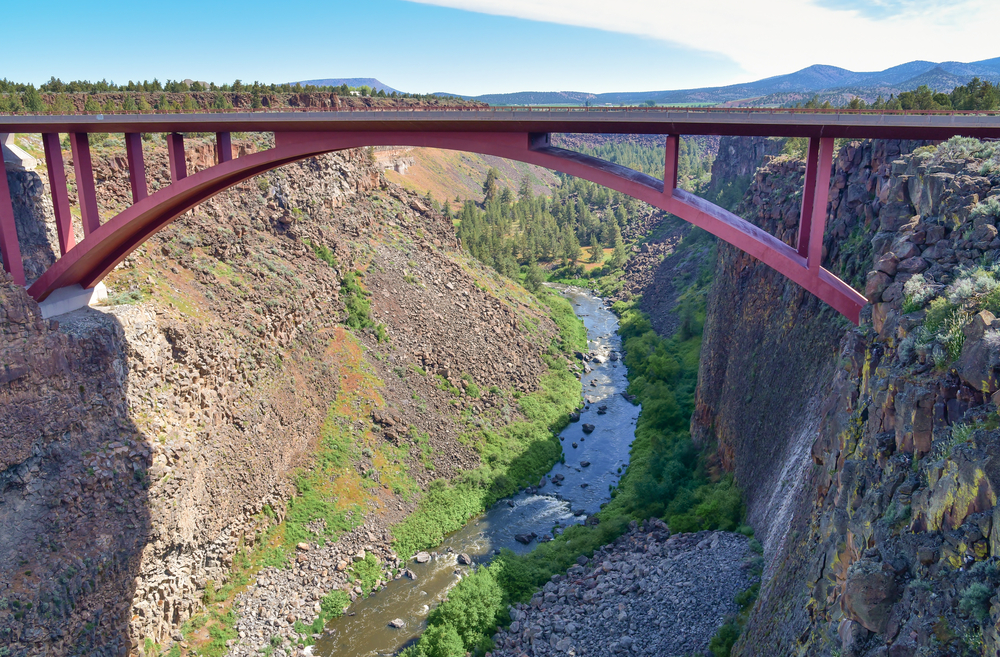
Crooked River Bridge was the initial name of the bridge, but the owners renamed it to honor World War II fighter pilot Rex T. Barber, known for shooting down the plane that transported Japanese Admiral Isoroku Yamamoto in 1943.
The concrete arch-designed bridge is 535 feet long, has a 410-foot arch span, and is 300 feet above the canyon. The road deck rises to a height of around 2,770 feet above sea level.
It was the United States’ first bridge built using cast-in-place segmental technology. They built the bridge in 2000 as the original could no longer handle US 97 traffic.

